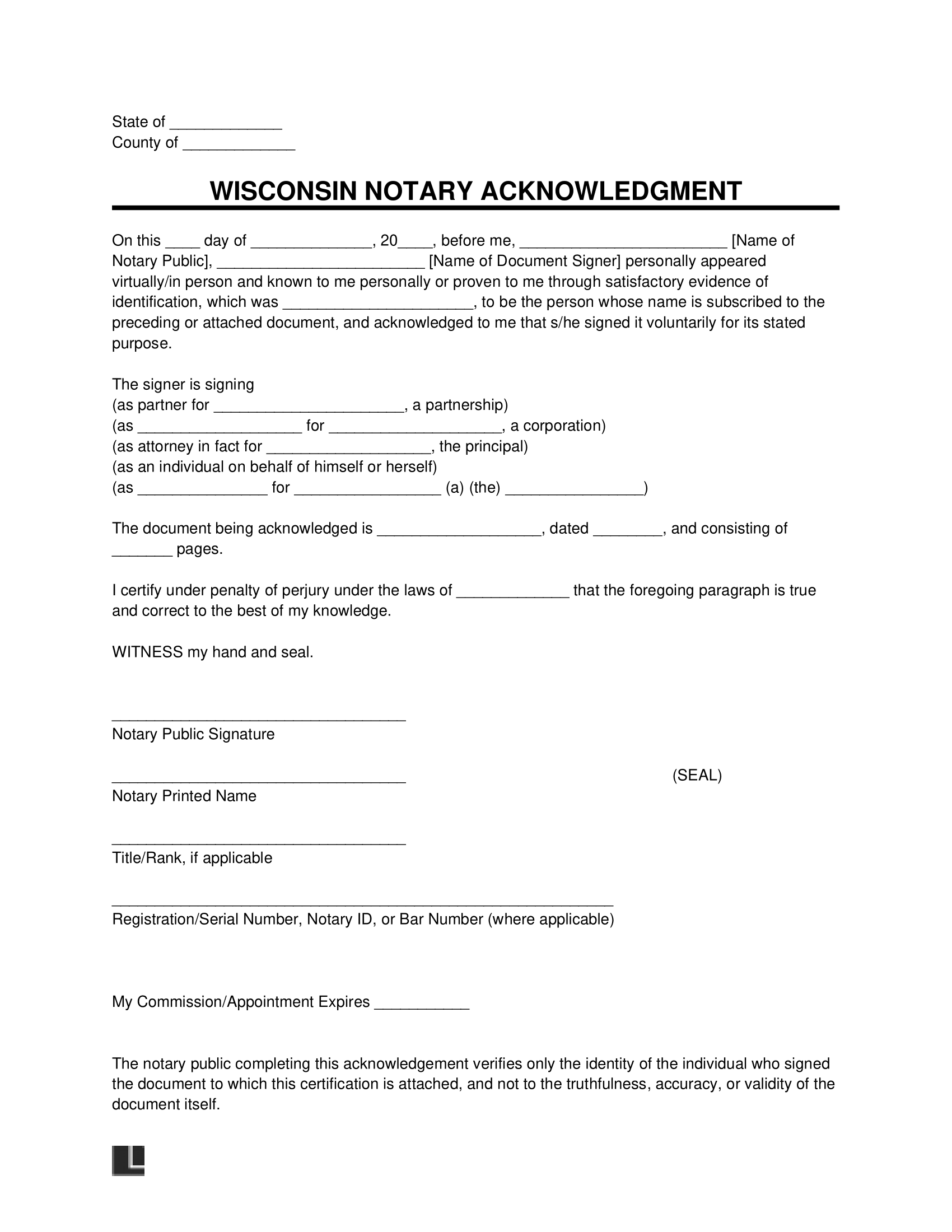A Wisconsin notary acknowledgment form is a legal instrument a notary public uses to validate signatures on documents like bills of sale, vehicle titles, and living trusts. To complete the acknowledgment, the requesting party should appear before the notary and provide their identity to the notary’s satisfaction.
The signing party must also confirm they’re signing the document willfully and for the purposes it states. Once the notary verifies all this information, they can sign the acknowledgment and affix their seal for validation.
Legal Considerations
Statute: Wisconsin Statutes Chapter 140.
Form of Acknowledgement: According to § 140.16, a short-form certificate of acknowledgment should include the county where it took place, the date, a certifying statement from the notary public, the notary’s signature, their stamp, and their title.
Notary Term of Commission: Four years (§ 140.02(1)(f)).
Notary Handbook: The state’s Department of Financial Institutions has a Notary Public Handbook describing how aspiring officers can seek commission and their powers and limitations once they obtain their titles.
Is Online Notarization Legal in Wisconsin?
Yes. With the passage of Senate Bill 317 in 2019, notaries can authenticate requesting parties’ signatures remotely. The notaries must use approved technology to perform their acts. Please note that this bill excludes most estate planning documents.
The state also imposes limits if the requesting party is outside the US at the time of signing. For example, the notary can only sign a document if it relates to a transaction substantially connected with the U.S., an affair involving a U.S. government entity, or a property located in U.S. territory.
How to Notarize
Step 1 – Locate a Notary
Locate a reputable notary. You can start looking at a credit union or bank, such as BMO Harris Bank. Other places to consider include city halls, public libraries, and government offices.
Step 2 – Bring Your Document
Bring your completed paperwork (like a power of attorney) to the notary. Prepare to pay $5, as this is the maximum a notary can charge for their services (§ 140.02(9)).
Step 3 – Present Your ID
If the notary knows you personally, you may not have to show your ID. Otherwise, you must present photo identification from a government authority. A credible witness whom the notary knows personally can also make an affirmation.
Confirm that you’ll sign the document while aware of its intended purpose.
Step 4 – Sign the Form
Sign the form before the notary. If you already signed it, verify that the signature on the paper is your own.
How to Verify a Notary
- Navigate to the Department of Financial Institutions’ Notary Public Search tool.
- Search for a notary by typing information into any of the following fields:
- First/last name
- City
- State abbreviation
- ZIP Code
- Commission date range (start and end dates)
- Refine your search further by filtering for inactive notaries and remote notaries only.
- View the search results to see each notary’s status.
How to Write (for Notary)
- Download a notary acknowledgment form in PDF or Word format.
- Write the date and county of acknowledgment.
- Name yourself and the signing party.
- Clarify who the signing party is signing for.
- State the evidence the signing party provides to prove their identity.
- Name the document you’re acknowledging.
- Sign your name.
- Add your seal, title, and status expiration date.


